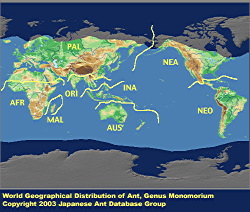
|
genus
|
Monomorium
|
 |

|
|
Japanese Name
|
Hime-ari-zoku
|
Original Reference
|
|
Mayr, G. (1855) Formicina austriaca. Beschreibung der bisher im sterreichischen Kaiserstaate aufgefundenen Ameisen nebst Hinzufgung jener in Deutschland, in der Schweiz und in Italien vorkommenden Ameisen. Verhandlungen des Zoologisch-Botanischen Vereins in Wien 5: 273-478.
|
Description
|
|
Small ants: total length of workers around 1.5 - 4 mm. Mandibles each with 3 - 5 teeth (mostly 4), the apical three distinct. Anterior margin of clypeus more or less produced, with a single median hair. Eyes varying in size, never absent. Occipital carina obscure. Antennae usually 12-segmented, rarely 10- or 11-segmented (12-segmented in all Japanese species); antennal club generally 3-segmented, sometimes obscurely segmentally differentiated; never 2-segmented. Pronotum and mesonotum fused, only slightly raised in profile. Metanotal groove variously developed between species. Propodeal spines absent; the propodeum sometimes with an angulate posterodorsal border. Subpetiolar process small or obscure.
|
|

|
Remarks
|
|
Workers are similar to minors of Solenopsis and Oligomyrmex, but distinguished by the antennal club segmentation and the presence of a single median hair on the clypeus. Monomorium species generally nest in plant cavities or under stones, and often forage on vegetation. Some species invade houses and buildings, nesting in structural spaces and damaging stored food and other materials. The genus comprises over 300 species, distributed mainly in the Afrotropical region. Nine species have been recorded from Japan.
|
Editor
|
|
Original text by Kazuo Ogata and Mamoru Terayama. English translation by Kazuo Ogata, edited by Robert W. Taylor.
|
|